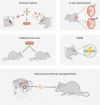Modeling pediatric medulloblastoma
- PMID: 31788908
- PMCID: PMC7317774
- DOI: 10.1111/bpa.12803
Modeling pediatric medulloblastoma
Abstract
Mouse models of medulloblastoma have proven to be instrumental in understanding disease mechanisms, particularly the role of epigenetic and molecular drivers, and establishing appropriate preclinical pipelines. To date, our research community has developed murine models for all four groups of medulloblastoma, each of which will be critical for the identification and development of new therapeutic approaches. Approaches to modeling medulloblastoma range from genetic engineering with CRISPR/Cas9 or in utero electroporation, to orthotopic and patient-derived orthotopic xenograft systems. Each approach or model presents unique advantages that have ultimately contributed to an appreciation of medulloblastoma heterogeneity and the clinical obstacles that exist for this patient population.
Keywords: Group 3; Group 4; MYC; MYCN; Sonic hedgehog; WNT; medulloblastoma; mouse models; patient-derived xenografts.
© 2019 The Authors. Brain Pathology published by John Wiley & Sons Ltd on behalf of International Society of Neuropathology.
Conflict of interest statement
The authors have no conflict of interest to declare.
Figures


Similar articles
-
A mouse model of the most aggressive subgroup of human medulloblastoma.Cancer Cell. 2012 Feb 14;21(2):168-80. doi: 10.1016/j.ccr.2011.12.023. Cancer Cell. 2012. PMID: 22340591 Free PMC article.
-
Establishment and characterization of an orthotopic patient-derived Group 3 medulloblastoma model for preclinical drug evaluation.Sci Rep. 2017 Apr 18;7:46366. doi: 10.1038/srep46366. Sci Rep. 2017. PMID: 28417956 Free PMC article.
-
Epigenetic regulation in medulloblastoma pathogenesis revealed by genetically engineered mouse models.Cancer Sci. 2021 Aug;112(8):2948-2957. doi: 10.1111/cas.14990. Epub 2021 Jun 17. Cancer Sci. 2021. PMID: 34050694 Free PMC article. Review.
-
Valproic Acid prolongs survival time of severe combined immunodeficient mice bearing intracerebellar orthotopic medulloblastoma xenografts.Clin Cancer Res. 2006 Aug 1;12(15):4687-94. doi: 10.1158/1078-0432.CCR-05-2849. Clin Cancer Res. 2006. PMID: 16899619
-
Matching mice to malignancy: molecular subgroups and models of medulloblastoma.Childs Nerv Syst. 2012 Apr;28(4):521-32. doi: 10.1007/s00381-012-1704-1. Childs Nerv Syst. 2012. PMID: 22315164 Free PMC article. Review.
Cited by
-
Not all mouse blood-brain barriers are created equal.Neuro Oncol. 2021 May 5;23(5):705-706. doi: 10.1093/neuonc/noab056. Neuro Oncol. 2021. PMID: 33713404 Free PMC article. No abstract available.
-
Preclinical Models of Craniospinal Irradiation for Medulloblastoma.Cancers (Basel). 2020 Jan 5;12(1):133. doi: 10.3390/cancers12010133. Cancers (Basel). 2020. PMID: 31948065 Free PMC article. Review.
-
In Vivo and Ex Vivo Pediatric Brain Tumor Models: An Overview.Front Oncol. 2021 Apr 1;11:620831. doi: 10.3389/fonc.2021.620831. eCollection 2021. Front Oncol. 2021. PMID: 33869004 Free PMC article. Review.
-
Human stem cell models to unravel brain cancer.BMC Cancer. 2024 Nov 28;24(1):1465. doi: 10.1186/s12885-024-13187-5. BMC Cancer. 2024. PMID: 39609728 Free PMC article. Review.
-
Single-cell transcriptomic sequencing identifies subcutaneous patient-derived xenograft recapitulated medulloblastoma.Animal Model Exp Med. 2025 Mar;8(3):458-472. doi: 10.1002/ame2.12399. Epub 2024 Mar 13. Animal Model Exp Med. 2025. PMID: 38477441 Free PMC article.
References
-
- Abdallah B, Hassan A, Benoist C, Goula D, Behr JP, Demeneix BA (1996) A powerful nonviral vector for in vivo gene transfer into the adult mammalian brain: polyethylenimine. Hum Gene Ther 7:1947–1954. - PubMed
-
- Ahronian LG, Lewis BC (2014) In vivo delivery of RCAS virus to mice. Cold Spring Harb Protoc 2014:1167–1169. - PubMed
-
- Ahronian LG, Lewis BC (2014) Using the RCAS‐TVA system to model human cancer in mice. Cold Spring Harb Protoc 2014:1128–1135. - PubMed
Publication types
MeSH terms
Grants and funding
LinkOut - more resources
Full Text Sources

